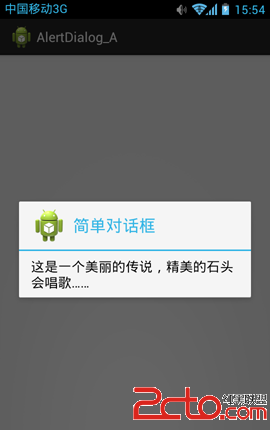編輯:Android技術基礎
本節和下一節文件下載一樣,慎入...現在實際開發涉及文件上傳不會自己寫上傳代碼,一般 會集成第三網絡庫來做圖片上傳,比如android-async-http,okhttp等,另外還有七牛也提供 了下載和上傳的API,喜歡的可以去官網查看相關的API文檔!本節的話有興趣看看就好!
思前想後,還是決定先貼下公司項目中用到的圖片上傳的核心方法,這裡用到一個第三方的庫: android-async-http.jar,自己到github下下這個庫~然後調用一下下面的方法即可,自己改下url!
上傳圖片的核心方法如下:
private void sendImage(Bitmap bm)
{
ByteArrayOutputStream stream = new ByteArrayOutputStream();
bm.compress(Bitmap.CompressFormat.PNG, 60, stream);
byte[] bytes = stream.toByteArray();
String img = new String(Base64.encodeToString(bytes, Base64.DEFAULT));
AsyncHttpClient client = new AsyncHttpClient();
RequestParams params = new RequestParams();
params.add("img", img);
client.post("http:xxx/postIcon", params, new AsyncHttpResponseHandler() {
@Override
public void onSuccess(int i, Header[] headers, byte[] bytes) {
Toast.makeText(MainActivity.this, "Upload Success!", Toast.LENGTH_LONG).show();
}
@Override
public void onFailure(int i, Header[] headers, byte[] bytes, Throwable throwable) {
Toast.makeText(MainActivity.this, "Upload Fail!", Toast.LENGTH_LONG).show();
}
});
}
 簡直臥槽...各種設置,各種麻煩...還是建議用1的方法吧,當然,實在太閒可以看看,
有輪子可用還是先別自己造輪子了...
簡直臥槽...各種設置,各種麻煩...還是建議用1的方法吧,當然,實在太閒可以看看,
有輪子可用還是先別自己造輪子了...
public class SocketHttpRequester
{
/**
* 發送xml數據
* @param path 請求地址
* @param xml xml數據
* @param encoding 編碼
* @return
* @throws Exception
*/
public static byte[] postXml(String path, String xml, String encoding) throws Exception{
byte[] data = xml.getBytes(encoding);
URL url = new URL(path);
HttpURLConnection conn = (HttpURLConnection)url.openConnection();
conn.setRequestMethod("POST");
conn.setDoOutput(true);
conn.setRequestProperty("Content-Type", "text/xml; charset="+ encoding);
conn.setRequestProperty("Content-Length", String.valueOf(data.length));
conn.setConnectTimeout(5 * 1000);
OutputStream outStream = conn.getOutputStream();
outStream.write(data);
outStream.flush();
outStream.close();
if(conn.getResponseCode()==200){
return readStream(conn.getInputStream());
}
return null;
}
/**
* 直接通過HTTP協議提交數據到服務器,實現如下面表單提交功能:
* <FORM METHOD=POST ACTION="http://192.168.0.200:8080/ssi/fileload/test.do" enctype="multipart/form-data">
<INPUT TYPE="text" NAME="name">
<INPUT TYPE="text" NAME="id">
<input type="file" name="imagefile"/>
<input type="file" name="zip"/>
</FORM>
* @param path 上傳路徑(注:避免使用localhost或127.0.0.1這樣的路徑測試,
* 因為它會指向手機模擬器,你可以使用http://www.baidu.com或http://192.168.1.10:8080這樣的路徑測試)
* @param params 請求參數 key為參數名,value為參數值
* @param file 上傳文件
*/
public static boolean post(String path, Map<String, String> params, FormFile[] files) throws Exception
{
//數據分隔線
final String BOUNDARY = "---------------------------7da2137580612";
//數據結束標志"---------------------------7da2137580612--"
final String endline = "--" + BOUNDARY + "--/r/n";
//下面兩個for循環都是為了得到數據長度參數,依據表單的類型而定
//首先得到文件類型數據的總長度(包括文件分割線)
int fileDataLength = 0;
for(FormFile uploadFile : files)
{
StringBuilder fileExplain = new StringBuilder();
fileExplain.append("--");
fileExplain.append(BOUNDARY);
fileExplain.append("/r/n");
fileExplain.append("Content-Disposition: form-data;name=/""+ uploadFile.getParameterName()+"/";filename=/""+ uploadFile.getFilname() + "/"/r/n");
fileExplain.append("Content-Type: "+ uploadFile.getContentType()+"/r/n/r/n");
fileExplain.append("/r/n");
fileDataLength += fileExplain.length();
if(uploadFile.getInStream()!=null){
fileDataLength += uploadFile.getFile().length();
}else{
fileDataLength += uploadFile.getData().length;
}
}
//再構造文本類型參數的實體數據
StringBuilder textEntity = new StringBuilder();
for (Map.Entry<String, String> entry : params.entrySet())
{
textEntity.append("--");
textEntity.append(BOUNDARY);
textEntity.append("/r/n");
textEntity.append("Content-Disposition: form-data; name=/""+ entry.getKey() + "/"/r/n/r/n");
textEntity.append(entry.getValue());
textEntity.append("/r/n");
}
//計算傳輸給服務器的實體數據總長度(文本總長度+數據總長度+分隔符)
int dataLength = textEntity.toString().getBytes().length + fileDataLength + endline.getBytes().length;
URL url = new URL(path);
//默認端口號其實可以不寫
int port = url.getPort()==-1 ? 80 : url.getPort();
//建立一個Socket鏈接
Socket socket = new Socket(InetAddress.getByName(url.getHost()), port);
//獲得一個輸出流(從Android流到web)
OutputStream outStream = socket.getOutputStream();
//下面完成HTTP請求頭的發送
String requestmethod = "POST "+ url.getPath()+" HTTP/1.1/r/n";
outStream.write(requestmethod.getBytes());
//構建accept
String accept = "Accept: image/gif, image/jpeg, image/pjpeg, image/pjpeg, application/x-shockwave-flash, application/xaml+xml, application/vnd.ms-xpsdocument, application/x-ms-xbap, application/x-ms-application, application/vnd.ms-excel, application/vnd.ms-powerpoint, application/msword, */*/r/n";
outStream.write(accept.getBytes());
//構建language
String language = "Accept-Language: zh-CN/r/n";
outStream.write(language.getBytes());
//構建contenttype
String contenttype = "Content-Type: multipart/form-data; boundary="+ BOUNDARY+ "/r/n";
outStream.write(contenttype.getBytes());
//構建contentlength
String contentlength = "Content-Length: "+ dataLength + "/r/n";
outStream.write(contentlength.getBytes());
//構建alive
String alive = "Connection: Keep-Alive/r/n";
outStream.write(alive.getBytes());
//構建host
String host = "Host: "+ url.getHost() +":"+ port +"/r/n";
outStream.write(host.getBytes());
//寫完HTTP請求頭後根據HTTP協議再寫一個回車換行
outStream.write("/r/n".getBytes());
//把所有文本類型的實體數據發送出來
outStream.write(textEntity.toString().getBytes());
//把所有文件類型的實體數據發送出來
for(FormFile uploadFile : files)
{
StringBuilder fileEntity = new StringBuilder();
fileEntity.append("--");
fileEntity.append(BOUNDARY);
fileEntity.append("/r/n");
fileEntity.append("Content-Disposition: form-data;name=/""+ uploadFile.getParameterName()+"/";filename=/""+ uploadFile.getFilname() + "/"/r/n");
fileEntity.append("Content-Type: "+ uploadFile.getContentType()+"/r/n/r/n");
outStream.write(fileEntity.toString().getBytes());
//邊讀邊寫
if(uploadFile.getInStream()!=null)
{
byte[] buffer = new byte[1024];
int len = 0;
while((len = uploadFile.getInStream().read(buffer, 0, 1024))!=-1)
{
outStream.write(buffer, 0, len);
}
uploadFile.getInStream().close();
}
else
{
outStream.write(uploadFile.getData(), 0, uploadFile.getData().length);
}
outStream.write("/r/n".getBytes());
}
//下面發送數據結束標志,表示數據已經結束
outStream.write(endline.getBytes());
BufferedReader reader = new BufferedReader(new InputStreamReader(socket.getInputStream()));
//讀取web服務器返回的數據,判斷請求碼是否為200,如果不是200,代表請求失敗
if(reader.readLine().indexOf("200")==-1)
{
return false;
}
outStream.flush();
outStream.close();
reader.close();
socket.close();
return true;
}
/**
* 提交數據到服務器
* @param path 上傳路徑(注:避免使用localhost或127.0.0.1這樣的路徑測試,因為它會指向手機模擬器,你可以使用http://www.baidu.com或http://192.168.1.10:8080這樣的路徑測試)
* @param params 請求參數 key為參數名,value為參數值
* @param file 上傳文件
*/
public static boolean post(String path, Map<String, String> params, FormFile file) throws Exception
{
return post(path, params, new FormFile[]{file});
}
/**
* 提交數據到服務器
* @param path 上傳路徑(注:避免使用localhost或127.0.0.1這樣的路徑測試,因為它會指向手機模擬器,你可以使用http://www.baidu.com或http://192.168.1.10:8080這樣的路徑測試)
* @param params 請求參數 key為參數名,value為參數值
* @param encode 編碼
*/
public static byte[] postFromHttpClient(String path, Map<String, String> params, String encode) throws Exception
{
//用於存放請求參數
List<NameValuePair> formparams = new ArrayList<NameValuePair>();
for(Map.Entry<String, String> entry : params.entrySet())
{
formparams.add(new BasicNameValuePair(entry.getKey(), entry.getValue()));
}
UrlEncodedFormEntity entity = new UrlEncodedFormEntity(formparams, encode);
HttpPost httppost = new HttpPost(path);
httppost.setEntity(entity);
//看作是浏覽器
HttpClient httpclient = new DefaultHttpClient();
//發送post請求
HttpResponse response = httpclient.execute(httppost);
return readStream(response.getEntity().getContent());
}
/**
* 發送請求
* @param path 請求路徑
* @param params 請求參數 key為參數名稱 value為參數值
* @param encode 請求參數的編碼
*/
public static byte[] post(String path, Map<String, String> params, String encode) throws Exception
{
//String params = "method=save&name="+ URLEncoder.encode("老畢", "UTF-8")+ "&age=28&";//需要發送的參數
StringBuilder parambuilder = new StringBuilder("");
if(params!=null && !params.isEmpty())
{
for(Map.Entry<String, String> entry : params.entrySet())
{
parambuilder.append(entry.getKey()).append("=")
.append(URLEncoder.encode(entry.getValue(), encode)).append("&");
}
parambuilder.deleteCharAt(parambuilder.length()-1);
}
byte[] data = parambuilder.toString().getBytes();
URL url = new URL(path);
HttpURLConnection conn = (HttpURLConnection)url.openConnection();
//設置允許對外發送請求參數
conn.setDoOutput(true);
//設置不進行緩存
conn.setUseCaches(false);
conn.setConnectTimeout(5 * 1000);
conn.setRequestMethod("POST");
//下面設置http請求頭
conn.setRequestProperty("Accept", "image/gif, image/jpeg, image/pjpeg, image/pjpeg, application/x-shockwave-flash, application/xaml+xml, application/vnd.ms-xpsdocument, application/x-ms-xbap, application/x-ms-application, application/vnd.ms-excel, application/vnd.ms-powerpoint, application/msword, */*");
conn.setRequestProperty("Accept-Language", "zh-CN");
conn.setRequestProperty("User-Agent", "Mozilla/4.0 (compatible; MSIE 8.0; Windows NT 5.2; Trident/4.0; .NET CLR 1.1.4322; .NET CLR 2.0.50727; .NET CLR 3.0.04506.30; .NET CLR 3.0.4506.2152; .NET CLR 3.5.30729)");
conn.setRequestProperty("Content-Type", "application/x-www-form-urlencoded");
conn.setRequestProperty("Content-Length", String.valueOf(data.length));
conn.setRequestProperty("Connection", "Keep-Alive");
//發送參數
DataOutputStream outStream = new DataOutputStream(conn.getOutputStream());
outStream.write(data);//把參數發送出去
outStream.flush();
outStream.close();
if(conn.getResponseCode()==200)
{
return readStream(conn.getInputStream());
}
return null;
}
/**
* 讀取流
* @param inStream
* @return 字節數組
* @throws Exception
*/
public static byte[] readStream(InputStream inStream) throws Exception
{
ByteArrayOutputStream outSteam = new ByteArrayOutputStream();
byte[] buffer = new byte[1024];
int len = -1;
while( (len=inStream.read(buffer)) != -1)
{
outSteam.write(buffer, 0, len);
}
outSteam.close();
inStream.close();
return outSteam.toByteArray();
}
}
偶然發現一篇以前轉載的,可以搭配著上面的看看...:使用HttpConnection上傳mp3文件
本節還是直接無視吧...關於文件上傳等進階部分直接教大家用第三方算了,項目中需要用到 第三方直接復制1的代碼,導入個android-async-http即可!
 第30章、常見對話框之一AlertDialog(從零開始學Android)
第30章、常見對話框之一AlertDialog(從零開始學Android)
在Android應用中,有多種對話框:Dialog、AlertDialog、ProgressDialog、時間、日期等對話框。 (1)Dialog類,是一切對話框的基類
 第39章、網格視圖GridView(從零開始學Android)
第39章、網格視圖GridView(從零開始學Android)
網格視圖對於需要有類似“九宮格”布局時非常有用。 一、設計界面 1、打開“res/layout/activity_main
 7.1.3 Android HTTP請求方式:HttpURLConnection
7.1.3 Android HTTP請求方式:HttpURLConnection
本節引言:前面兩節我們學習的都是一些概念性的東西,Http的協議以及協議頭的一些東東,而本節我們就要堆碼了,而本節學習的是Android為我們提供的
 第92章、廣播之三通過廣播啟動服務(從零開始學Android)
第92章、廣播之三通過廣播啟動服務(從零開始學Android)
Service(服務)在Android中地位是至關重要的,我們可以通過Activity與Broadcast(廣播)啟動Service(服務),我們本章學習如何通過廣播Br